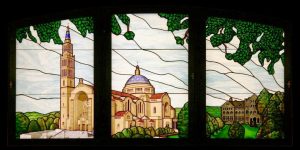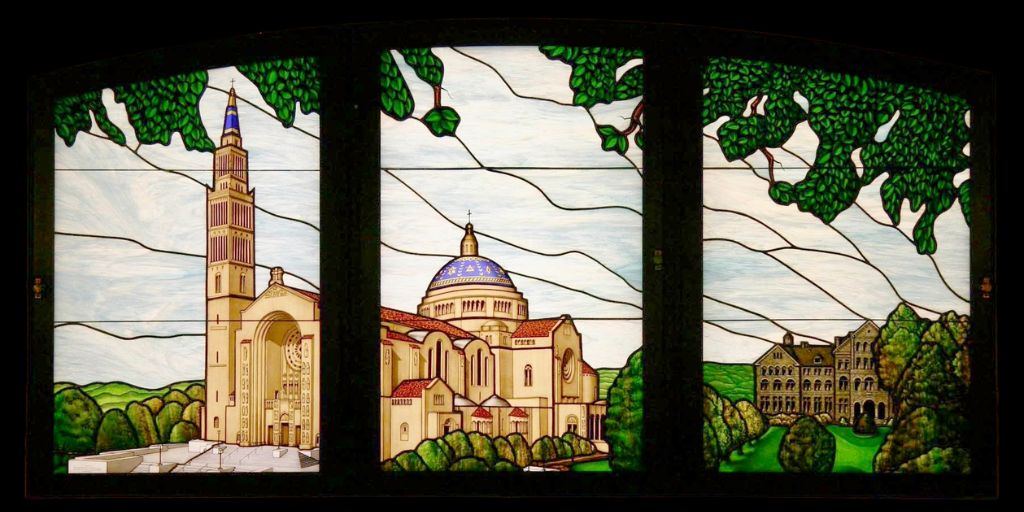
From the desk of Dr. Geraldine M. Rohling, MAEd, DSG, Archivist-Curator Emerita
In ancient times, the characteristic feature of worship was sacrifice. The food for the meals in the temple dining rooms came from that which was not used in the sacrifice itself, a form of “leftover.” What was clear, however, was that the sacrifice and the meal were paired together. Those who ate the food for the sacrifice were, as Paul wrote to the Corinthians, “sharers in the altar.”
“Is not the cup of blessing which we bless a sharing in the blood of Christ? Is not the bread which we break a sharing in the body of Christ? Since there is one bread, we who are many are one body; for we all partake of the one bread. Look at the nation Israel – are not those who eat the sacrifices sharers in the altar?” – 1 Corinthians 10:16-18
From the days of the Passover to the Eucharist of today, sharing a meal has been central to our worship practice.
It was the intention of the founder of the National Shrine, and it has been the intention of every administration ever since, to help pilgrims and visitors find spiritual meaning in their daily lives and in their ordinary activities. To “educate in the faith” or “to catechize” is part of the mission of the National Shrine. One of the ways in which this mission is fulfilled is in the works of art featured throughout the church.
Cafeteria Improvements and the Installation of the Eucharist Windows
In 1997, after the completion of the bookstore, the renovation of the west corridor, and the improvements made to the east corridor and visitor’s entrance, it was obvious that the cafeteria needed significant improvements. This included changing the décor and the furnishings from that of a cafeteria with booths, to a dining area with tables and padded chairs. To further enhance the ambience of the dining room, five stained glass windows were installed along the south wall. They measure four feet by eight feet and depict various Gospel accounts of Our Lord and the Apostles sharing food together.
Several Scripture scholars were consulted and gave input as to which scenes, nuances, and details to include in each window. These five windows were designed and created by Mr. Art De Carlo and his associate, Mr. Geno Zang of Centreville, Virginia. A little bit of trivia: one of the attendees seated at the table in the Cana window was modeled after one of the security guards who worked at the National Shrine at that time.
Learn more about the Eucharist Windows as they appear from left (east entrance) to right (west entrance) in the cafeteria below!
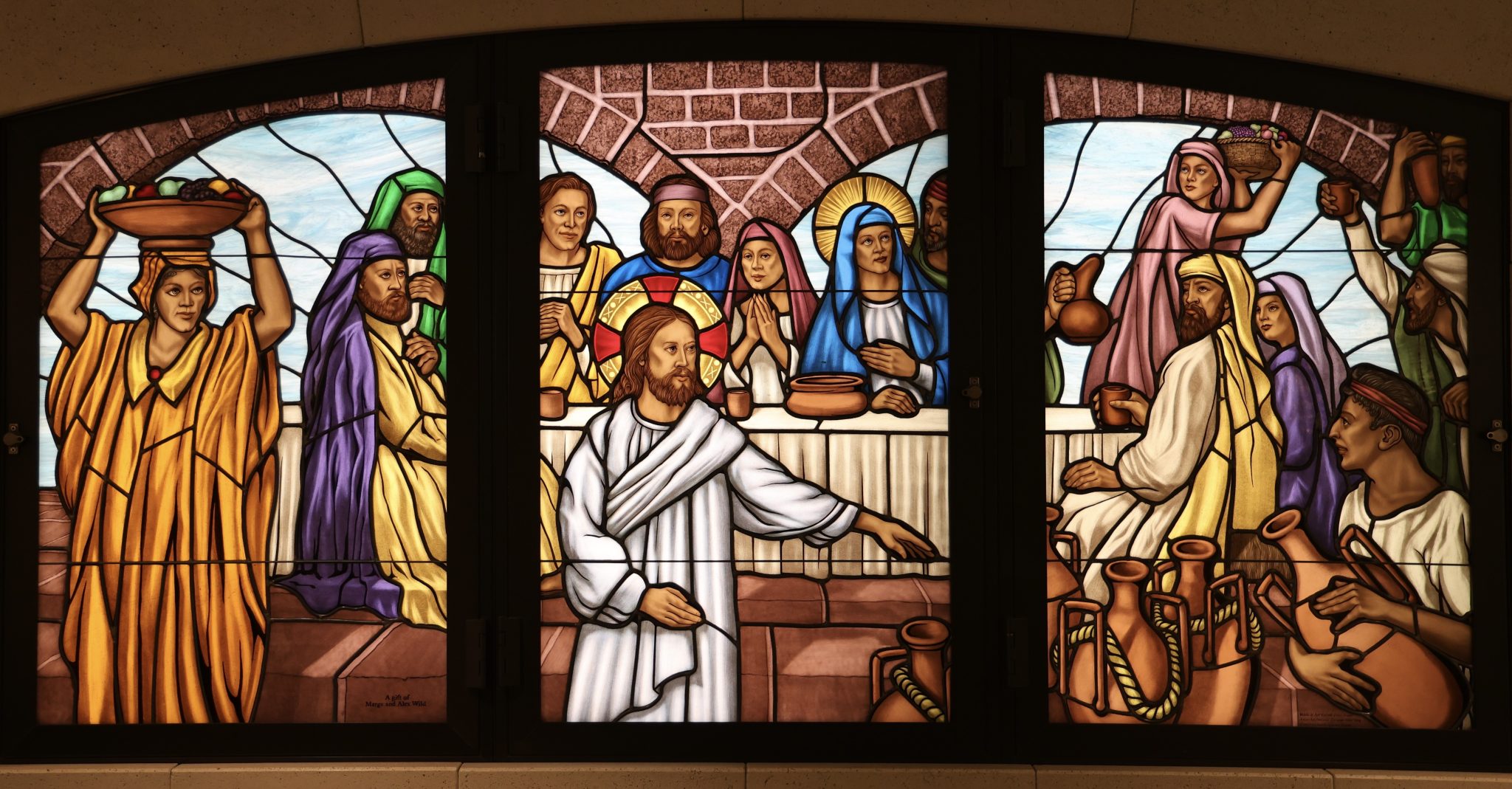 The Wedding Feast of Cana
The Wedding Feast of Cana
This window is the gift of Marge and Alex Wild. This story is recounted only in the Gospel of John (2:1-11). Bishop Fulton J. Sheen, a frequent celebrant and preacher at the National Shrine, thought it highly likely that this particular wedding was that of a relative of Mary, the mother of Jesus. Scholars have also speculated as to the identity of the bridegroom. Thomas Aquinas, along with others, thought that it was John, the evangelist, the one writing the story. This belief goes back to the eighth century and the works of Venerable Bede, an English monk known for his exegetical erudition and Biblical commentaries.
The Gospel specifically tells of six stone jars being present. Different artistic representations have included fewer jars, depending on the intent of the artist and whether the jars are to be literal or symbolic. In this window, only five jars are visible—one jar is presumed “hidden” behind the frame of the window.
 The Miracle of the Multiplication of the Loaves and Fishes
The Miracle of the Multiplication of the Loaves and Fishes
This window is the gift of the Diocese of Pittsburgh, Bishop Donald Wuerl, to mark the 150th anniversary of the diocese.
There are two stories of Jesus feeding the multitude – that of the 5,000, which, along with the resurrection, is the only miracle recorded in all four gospels: Matthew 14:13–21; Mark 6:31–44; Luke 9:12–17; and John 6:1–15, and that of the 4,000, with seven loaves of bread and a few small fish, as reported only in Matthew 15:32–39 and Mark 8:1–9.
This window illustrates the first story, the feeding of the 5,000. In all four gospel accounts, there are five loaves of bread and two fish, as depicted in the window. Bishop John H. Ricard S.S.J., Pensacola-Tallahassee, asked that the original title of this window be changed to its current name. This was to make bold the miraculous ability of Jesus to feed the throng with only five loaves and two fish and would offer a new catechetical insight to viewers.
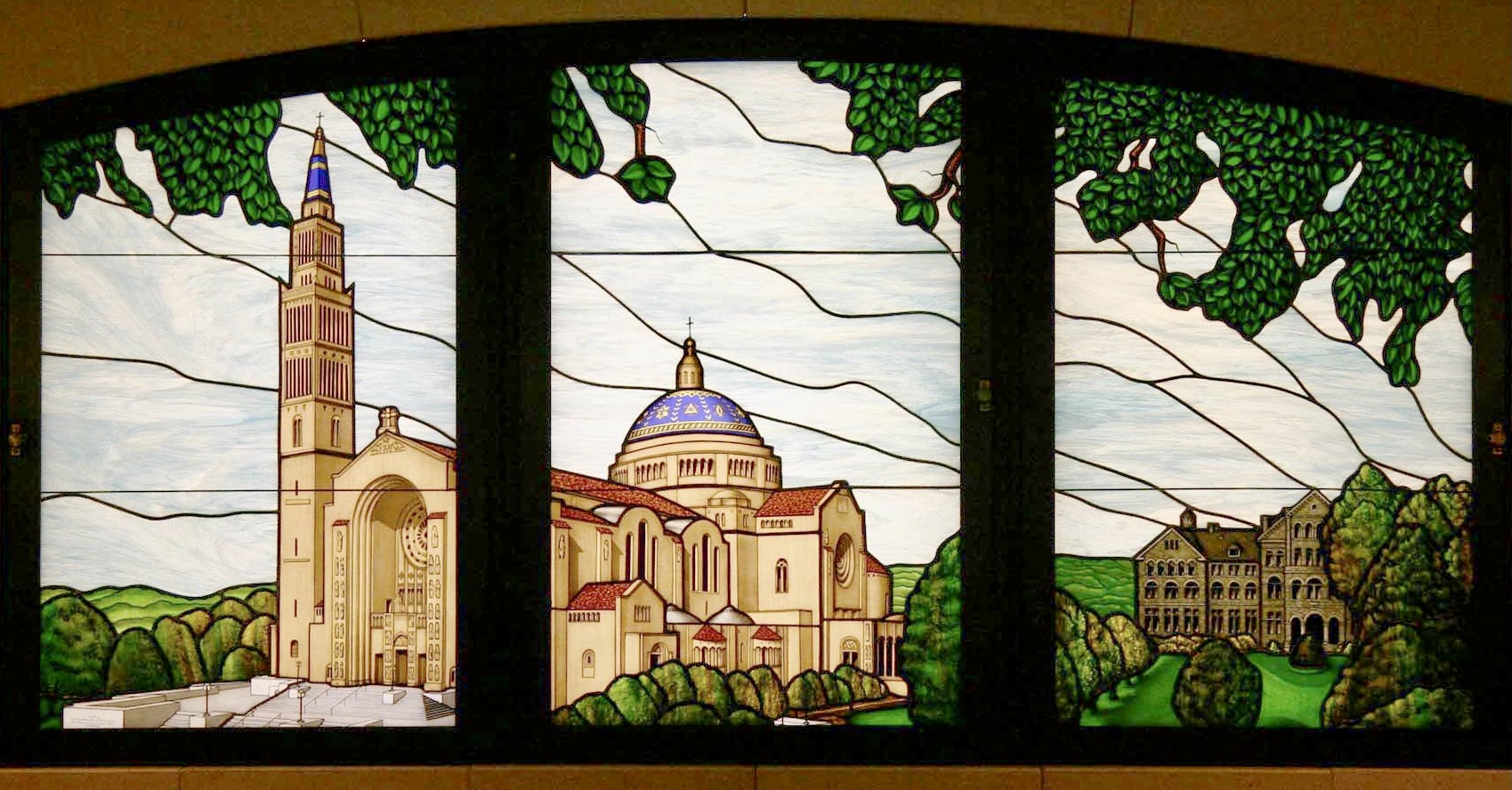 The National Shrine
The National Shrine
This window is the gift of the Archdiocese of Washington and James Cardinal Hickey, Archbishop and Chairman of the National Shrine Board of Trustees. Brother Patrick Ellis, FSC, who was president of The Catholic University when the window was designed – and a member of the National Shrine Board of Trustees – asked to have McMahon Hall, the administrative building of the university at that time, included in this window.
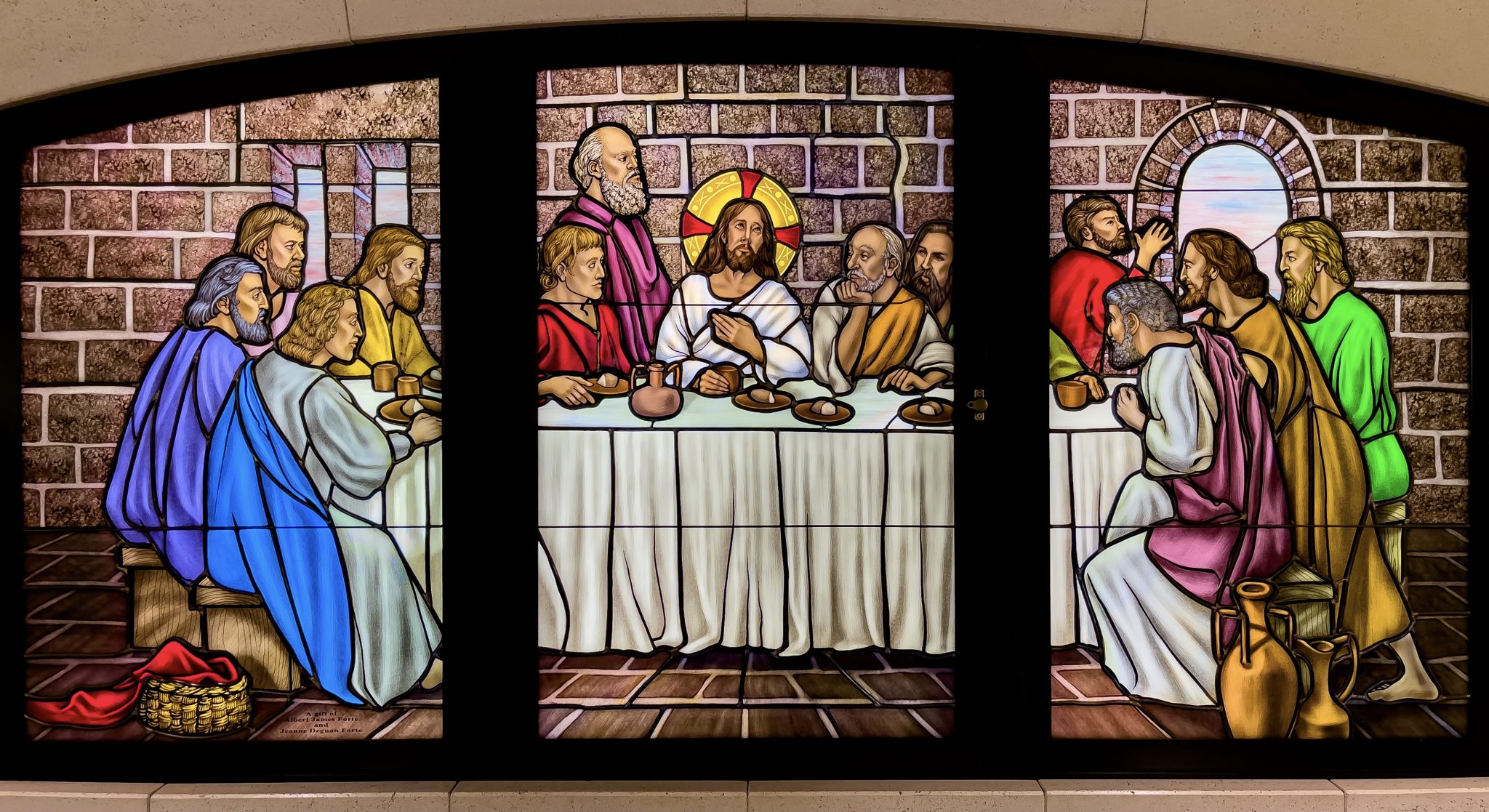 The Lord’s Supper
The Lord’s Supper
This window is the gift of Albert Forte and Jeanne Degnan Forte.
The last meal that Jesus shared with His apostles, specifically the blessing of the bread and wine, is recorded in the synoptic Gospels: Matthew 26:26–30; Mark 14:12–16; and Luke 22:14–20. In this window depiction, Judas is not shown at the table, but in the background, already taking his leave to fulfill his betrayal. This part of the scene is from the account of John: “After he took the morsel, Satan entered him. So, Jesus said to him, ‘What you are going to do, do quickly.’ … So, he took the morsel and left at once. And it was night,” (John 13:27, 30).
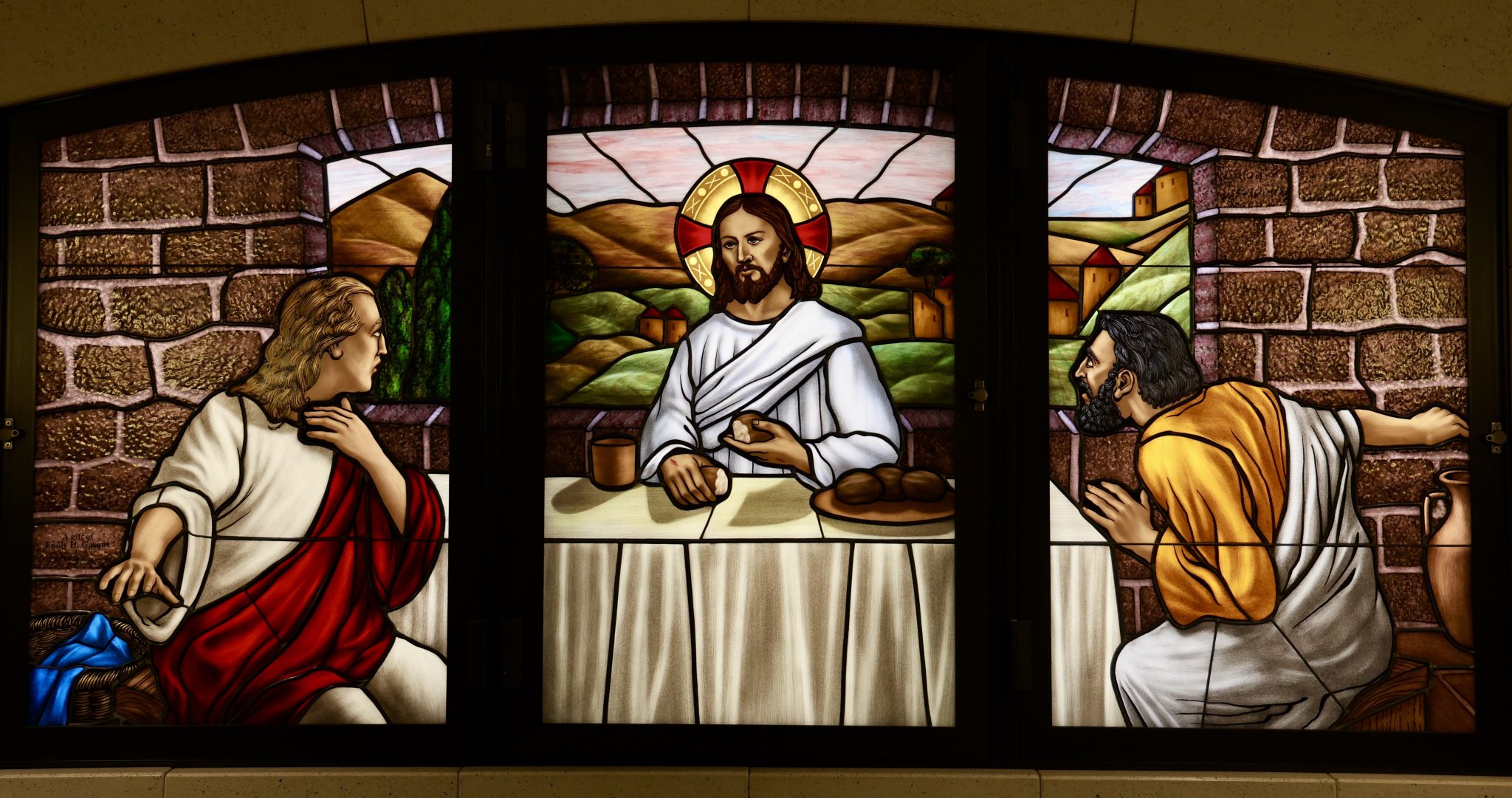 Meal at Emmaus
Meal at Emmaus
This window was donated by Emily H. Gasque.
This story is only in the Gospel of Luke 24:13–35. It is often referred to as a “post-resurrection” appearance. It seems these two men were disciples and separate from the original 11 (except Judas). At the end of the account, Luke tells us that when they “returned to Jerusalem… they found gathered together the eleven.”
In Chapter 24, Luke tells us “Now that very day,” the day that Mary Magdalene, Joanna, and Mary the mother of James, had seen the empty tomb and had gone and reported this news to “the eleven and all the others” (v. 9-10), “two of them were going to a village seven miles from Jerusalem called Emmaus.” It was during this journey that Jesus drew near and began speaking with them about the past events. They were astounded at the stranger’s obliviousness to the recent events and said, “It is now the third day since this took place. Some women from our group, however, have astounded us: they were at the tomb early in the morning and did not find His body; they came back and reported that they had indeed seen a vision of angels who announced that He was alive,” (v. 21-23). Once they arrived in the village, the two men said to Jesus, “stay with us,” still not knowing who He was. As they sat at the table, preparing to share a meal, Jesus took bread, “said the blessing, broke it, and gave it to them. With that their eyes were opened, and they recognized Him, but He vanished from their sight,” (v. 30-31).
In the 38 days between the resurrection and ascension of Jesus—40 if counting from His crucifixion—Jesus appeared several times to His apostles and disciples. Scripture speaks of 13 encounters, beginning with that of Mary Magdelene at the tomb (Mark 16:9-11; John 20:11-18), and then when the other two women went with Mary to anoint the body (Matthew 28:9-10). The Emmaus story is the fourth appearance. The final appearance was with His apostles on the day of His ascension (Acts 1:9-12; Mark 16:19-20; Luke 24:50-53). They shared a meal in Jerusalem after which Jesus led them to a place in Bethany, on the Mount of Olives, where He ascended into heaven.
Every time we “sit at table” with family, friends, colleagues, or even individually, we can “say the blessing, break the bread, and share it” as Jesus had commanded.
This Holy Week, take a moment to visit the dining room of the National Shrine. Bring your Bible, read the Scripture passages given above, and spend a few moments in meditation. Enjoy a snack with family, friends, or individually, and remember—whether at the Shrine or at home—that we are “sharers in the altar.”

